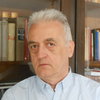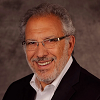Hello Visitor! Log In
Origins and Pathways for the Future of the World Academy of Art & Science Strategic Perspectives and Opportunities
ARTICLE | March 6, 2024 | BY Garry Jacobs, Janani Ramanathan, Amanda Ellis, Phoebe Koundouri, Nebojša Nešković, Donato Kiniger-Passigli, Ketan Patel, Ivo Šlaus, Walton Stinson, Ralph Wolff, Alberto Zucconi
Author(s)
Garry Jacobs
Janani Ramanathan
Amanda Ellis
Phoebe Koundouri
Nebojša Nešković
Donato Kiniger-Passigli
Ketan Patel
Ivo Šlaus
Walton Stinson
Ralph Wolff
Alberto Zucconi
Abstract
The purpose of this paper is to lay the foundation for development of a new strategic plan for the work of the Academy to 2030. Its aim is to invite suggestions from WAAS members and partners regarding priorities for future work. It traces the origins and historical development of the Academy leading up to the present and provides an overview of recent activities and emerging opportunities aligned to its mission which were presented at a meeting of the Board of Trustees at the Academy of Athens in November 2023. The paper ends with a call for proposals from WAAS Fellows for topics to be discussed at an upcoming conference and general assembly of the Academy in mid-2024 as well to be considered during the WAAS strategic Planning Process.
CONCEPT NOTE FOR WAAS@64 CONFERENCE & GENERAL ASSEMBLY
1. Executive Summary
This essay seeks to capture essential insights regarding the past, present and future work of the World Academy of Art & Science. The ideas discussed are drawn from records, a survey of WAAS Fellows and a series of interviews with WAAS Trustees in October 2023, the President’s Report to the Board and other presentations and discussions that took place during a three-day meeting of the Board of Trustees at the Academy of Athens in Greece during November 2023. These activities examined the circumstances and original intention which led to the founding of the Academy in 1960, an overview of its development during the past six decades, the rapidly changing context of the 2020s, and the prospects for significantly expanding the scope of WAAS activities and enhancing their impact during the rest of this decade.
Since the founding of WAAS in 1960, the Academy has placed great emphasis on the need for new thinking characterized by transnational, transdisciplinary, human-centered, values-based perspectives and theories that integrate the objective and subjective dimensions of knowledge. The Academy is now in the midst of a transition toward greater emphasis on translating new thought into practical action with concrete impact on the challenges confronting humanity today. At the same time, it should not neglect the quest for new ideas and theoretical perspectives which are essential for comprehending and addressing the challenges we confront due to the very nature of our humanity and complex social processes.
The aim of this paper is to examine the strategic contours of the Academy’s work to identify prominent potential lines of future programming that have emerged from recent events and the Academy’s recent activities which can give greater expression to its mission of “Leadership in thought that leads to action”. The paper is intended to serve as a think-piece preparatory to an online conference and general assembly of WAAS in May-June 2024. It seeks to stimulate fresh thinking and discussion among members of the Academy, leading ultimately to the formulation of a strategic plan for activities during the remainder of this decade and beyond. The ideas and proposals presented in this paper are indicative and suggestive of the magnitude of the challenges and opportunities which lay open for us to seize.
"Never doubt that a small group of thoughtful, committed citizens can change the world; indeed its the only thing that ever has." - Margaret Mead
2. Origins And Evolution of WAAS
WAAS was founded in 1960. However, its origins date back to momentous events that shaped the course of world history in the 1940s and ‘50s. They include the establishment of the Manhattan Project under the leadership of J. Robert Oppenheimer, the atomic bombing of Japan, the start of the Cold War, the division of Europe into rival blocs, and the onset of the nuclear arms race. These events were all linked to dramatic advances in the power of science and technology which transformed all aspects of life during the latter half of the 20th century and generated deep concern regarding the impact of science on the future welfare of humanity. One dramatic expression of this transformation was the release of the
Russell-Einstein Manifesto in 1955 which declared:
“Renounce war or perish!, World peace or death! We appeal as human beings to human beings: Remember your humanity, and forget the rest.”
The Academy was a child of these events. The Manifesto led to the First International Conference on Science and Human Welfare in Washington DC in 1956, at which leading intellectuals discussed the future of humankind and recognized the social responsibility of science for the unfolding course of events.
“We scientists who released this immense power have an overwhelming responsibility in this world’s life-and-death struggle to harness the atom for the benefit of mankind and not for humanity’s destruction.” – Alberto Einstein
Its aim was to chart a peaceful course for global social progress toward a future in which all mankind will be able to enjoy the immense achievements of the human mind. The conference led directly to the establishment of WAAS on December 24, 1960, with the call:
“Non-Scientists and Scientists alike! Let us all help to make this forum a true ‘Agency for Human Welfare’ irradiating hope and belief, and let us work together for a brighter future, a future truly adequate for “Homo sapiens.” *
"Solutions to complex social problems require knowledge that transcends disciplinary boundaries and can only be effectively addressed by an effort to comprehend underlying root causes and transdisciplinary social processes."
The Academy was established with the explicit aim of marrying scientific knowledge and artistic sensibilities with universal human values. It sought to become an independent, transnational, non-partisan association of eminent individuals concerned with the policy implications and social consequences of rapid advances in different fields of knowledge. Among its founders were J. Robert Oppenheimer and four of the eleven signatories of the Manifesto—Albert Einstein, Bertrand Russell, Joseph Rotblat and Hermann Muller. They also included five Nobel Laureates and the founding Director Generals of UNESCO, FAO and WHO: Joseph Needham, Lord Boyd Orr, and G. Brock Chisholm.
During this period, untoward events continued to unfold dramatically, reinforcing their concern and the need for action. Two years later in October 1962, the Cuban Missile Crisis brought the world to the brink of nuclear war. This was followed by the first Nuclear Test Ban Treaty in 1963 and the Nuclear Non-Proliferation Treaty in 1968.
It was also a period in which dramatic technological advances in transport and telecommunications brought the world closer together. In parallel with the invention of powerful weapons, science brought succor to humanity in the form of life-saving antibiotics and vaccines, such as the polio vaccine developed by WAAS Fellow Jonas Salk. These developments had unanticipated social consequences.
Falling death and infant mortality rates led to the population explosion that began in the ‘50s and growing threats of famine in the following decade when growth in food production could not keep pace with the growth of population. The social consequences of population growth and food production became issues of major concern to WAAS during its first decade.
2.2. Reliable Knowledge
The need for new ways of thinking permeated the work of the Academy. A sense of responsibility for the consequences of scientific discoveries and an approach to phenomena from a transnational, indeed global, perspective were prominent characteristics that distinguished WAAS from the approach of most other organizations at the time. But the Academy’s founders also realized that solutions to complex social problems require knowledge that transcends disciplinary boundaries and can only be effectively addressed by an effort to comprehend underlying root causes and transdisciplinary social processes. From single issues, they gradually extended the scope of its work to embrace the full gamut of social challenges related to peace, disarmament, population, food and the even more complex problems related to the environment.
From its outset the mission of the Academy has been to transcend conventional thinking and seek out new perspectives integrating science and art with ethics and universal values. WAAS was founded to study the impact of knowledge on policy and society, which means its relevance to human beings. Out of this effort has emerged a multidimensional conception of reliable knowledge based on an inclusive and integrated transdisciplinary perspective applicable to social problems and opportunities in all fields.†
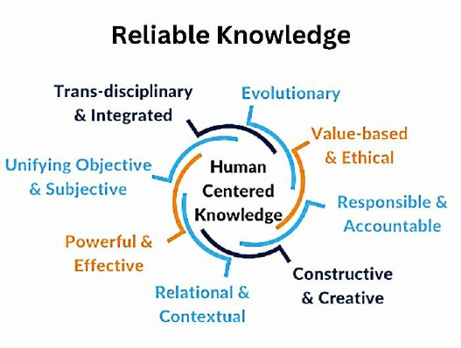
2.3. Integrating Art and Science
“Science without art is sterile, art without science is blind”. – Leonardo da Vinci
“Science is the search for truth; art is the expression of truth”. – Max Planck
“All religions, arts and sciences are branches of the same tree. All these aspirations are directed toward ennobling man’s life, lifting it from the sphere of mere physical existence and leading the individual towards freedom.”– Albert Einstein
The Academy’s founders recognized that scientific knowledge alone was insufficient to either understand or guide humanity through the complex nexus of forces propelling the rapid evolution of global society. They regarded art and science as two complementary ways of knowing, one founded on objective facts and rational thoughts, the other on subjective values and intuitive perception. These diverse perspectives converse and converge with one another to generate a way of knowing greater than the sum of its parts.
Art and Science were perfectly integrated by geniuses such as Leonardo da Vinci, who was a master of both universes. Scientific knowledge, as Einstein said, has a very precise contour and dimension, while artistic imagination and creativity are boundless. Science without Art is unimaginative and mechanistic. Art, through a scientific approach, transforms abstract knowledge into concrete applications.
There is no dichotomy between these two branches. Creativity in science and art are closely related processes. Serious efforts are needed to accelerate the integration of these two branches of knowledge in education and in various forms of knowledge discovery and expression. Our complex and interconnected global problems necessitate an interdisciplinary approach by which leading thinkers across disciplines and sectors share ideas and insights.
WAAS is a melting pot of thinkers from diverse disciplines, professions and fields of life experience. It offers a platform where they can collaborate to come up with holistic and sustainable solutions. The Academy was founded as a transnational, trans-disciplinary academy of art and science in order to integrate the objective perspectives of science with the subjective insights drawn from the arts. At the heart of the Academy are the values which motivated its establishment and continue to inspire its work. Its work was to focus on the social consequences and policy implications of knowledge. Its aim was to provide thought leadership as an “Agency for Human Welfare.”
“Let us create the scientific basis which is necessary to enable us to live and work together peacefully. Let us use all our imagination to make an art of living.” – First International Conference on Science & Human Welfare, Washington DC, 1956
3. New Paradigm Roadmap 2010-2020
Earlier efforts to align the work of the Academy with the pressing needs of the 21st century were initiated by the WAAS Board in 2010 and renewed in 2020 before the onset of
COVID-19. Both initiatives concluded that the Academy’s original mission remained fully relevant to the rapidly changing environment of current times, but the scope, magnitude, speed and complexity of the issues required a reframing of strategy and focus. Both concluded that a piecemeal focus on single issues would be inadequate at a time when the inter-linkages and interdependencies between issues, disciplines, sectors, regions and cultures of an increasingly globalized world had become so evident and determinative.
The first major thrust for WAAS after the 2008 Financial Crisis was the establishment of Cadmus Journal by WAAS Fellows in 2010 and the formation of a transdisciplinary working group on New Economic Theory which eventually grew to include more than fifty members drawn from a wide range of disciplines, both within and outside the conventional boundaries of Economics.‡ During the next decade WAAS partnered in five international colloquia and more than twenty other conferences and seminars exploring diverse dimensions of current economic theory, policy and social impact at the national and global level. The thrust of the program was the call for formulation of human-centered economic theory (NET), which placed security, welfare, well-being and sustainability as the foremost objectives of economic policy. The program has generated more than 100 articles on various dimensions of economic theory in Cadmus.§
In 2019 WAAS was invited to partner with UNCTAD and the UN Office for Partnerships for the launch of the Future Capital Initiative at the UN in New York¶ which led to a shift in focus to the role of money, capital and financial strategies as an engine for human security and well-being and for funding Agenda 2030. The Future Finance project led to the publication of nearly fifty articles in Cadmus and ten books and reports by WAAS Fellows on related issues. This activity includes ongoing collaboration with Force for Good** on the role of finance and technology in global development and with the Tao of Finance†† on an innovative application of central bank digital currencies to bridge the funding gap that is needed to achieve the human security and sustainable development objectives of Agenda 2030.‡‡
The work on economic theory exposed fundamental limitations in the prevailing approach to addressing global challenges and opportunities, which gradually led to a shift in the central focus of the Academy’s work. First, it made evident the need for a transdisciplinary theory of economics which takes into account the growing interconnectedness and interdependence of other dimensions of global social activity, including the evolution of political systems and human rights, technological development and environmental impact. Second, NET underlined the fact that all the major challenges confronting global society are inter-related and interdependent and that none can be effectively addressed in isolation from the others. Therefore the 17 SDGs should be addressed in concert with one another. Third, it highlighted the need to take into account subjective factors in the functioning of economic systems, including the influence of social values and the subtle play of all forms of social power, as reflected in the Academy’s conception of reliable knowledge. Finally, it also made evident that globalization imposed severe limitations on the ability of nation-states to apply policies and goals inconsistent with the wider consensus of global society due to the porosity of borders, the growing interdependence of supply chains and markets, and the increasing impact of global forces and challenges on nation-states. The interdependence between the nations and people of the world compelled the evolution of a new consensus in economics. The unanimous adoption of the 17 Sustainable Development Goals (SDGs) under Agenda 2030 by 193 countries was an expression of that compulsion. Problems related to poverty, migration, biodiversity and, most especially, climate change, could only be addressed through global multilateral cooperation. These conclusions led inevitably to a broadening of the Academy’s focus from economics and finance to a need for new thinking on the complex nexus of forces and issues posing challenges to global society in the 21st century.
3.2. New Paradigm for Global Development
In 2013 WAAS initiated a project in collaboration with the United Nations Office at Geneva (UNOG) to study the multidimensional global challenges confronting humanity and the deep-seated processes driving global social evolution in areas related to peace, health, food security, economic inequality, employment, finance, environment and climate change. During this period the world came under increasing distress from rapid technological, economic, financial, social, environmental and cultural forces. This distress had created deep fissures in the existing system and institutions of global governance. Confidence in government, business and the media had already begun a steep decline. Only science retained high levels of public trust and confidence. The widening divergence of progressive and regressive forces had begun to disrupt social cohesion, undermine confidence in the multilateral system of international relations, sow seeds of discord in society and spur a retreat from democracy. The zigzag patterns of advance and retreat, affirmation and denial, challenged conventional theories and concealed deeper lines of social evolution advancing beneath the surface turmoil.
The project led WAAS to the conclusion that the challenges of our times share a number of common characteristics. All are global in scope, and none can be effectively addressed by individual nation-states or even regions acting independently of one another. Thus, a transnational approach with emphasis on the role of multilateral institutions is imperative. Actions in each sector have to be understood and addressed in coordination with the others.
The project also drew two other important conclusions. First, that all these changes would not be feasible unless they are based on fundamental changes in our concept of knowledge. Building on earlier efforts of the Academy it projected a comprehensive, integrated conception of Reliable Knowledge. This resulted in a series of more than a dozen curriculum development programs examining existing concepts and theory and sketching the outlines for evolving new perspectives and approaches to global issues.
Finally, the project challenged traditional concepts and forms of leadership deemed inadequate to cope with the challenges confronting humanity today. Innovative approaches will be needed to fill the leadership vacuum. This gave rise five years later to the launching of the GL-21 project, Global Leadership in the 21st century, in 2019 in renewed collaboration with UNOG.
3.3. Catalytic Strategies for Global Leadership
Building on the work of the Millennium Development Goals during the previous 15 years, in 2015, 193 nations of the world came together and adopted for the first time a comprehensive program of action to achieve 17 Sustainable Development Goals (SDGs) which were delineated by 169 specific targets to be realized by every nation. As Jeffrey Sachs pointed out, these goals for the first time sought to generate concrete commitment of the world to ideas first enshrined in the Universal Declaration of Human Rights in 1948.
The unprecedented landmark agreement of 193 nation states to achieve the SDGs was a source of encouragement and optimism during the period 2015 and 2019. The formulation was a dramatic achievement of the multilateral system and demonstrated the indispensable role it would have to play in the future in order to effectively address global challenges. The initial enthusiastic commitment of nation-states to the SDGs led to considerable progress during the first five years and growing confidence that many of the goals could be achieved.
But the magnitude of the challenges humanity confronted soon made it evident that business–as-usual and more of the same strategies would not be sufficient to achieve the goals. The political composition of the multilateral system and the self-interest of national governments and public opinion and vested interests posed too great an obstacle to be overcome by a mere public commitment to Agenda 2030 without the authority and resources required for implementation. Fundamental changes would be required in both the architecture and strategies employed.
In 2020, WAAS and UNOG renewed their collaboration to address the increasingly evident leadership gap by drawing on the expertise and experience of some 60 collaborating organizations, 14 working groups, and 250 experts from multilateral institutions, governments, business, academia, civil society and the arts.§§ The project examined global challenges and opportunities and explored the potential for a wide range of catalytic initiatives to overcome obstacles to global progress. The interim report issued by WAAS and UNOG in September 2020 addressed five interdependent pillars of a comprehensive approach to building global leadership and social momentum—Redefining Multilateralism, Sustaining Peace and Human Security, Mobilizing Civil Society, Innovative Strategies for Financing Implementation of the SDGs, and Transforming Global Education. Under each pillar, it identified key thrust areas for breakthrough initiatives. It also outlined issues to be addressed by further work.¶¶
This report concluded that in spite of the unprecedented global challenges, there is a growing recognition among a wide range of international stakeholders that the current crisis situation also offers a unique opportunity to launch humanity into a more dynamic, equitable, resilient, and sustainable phase of global social evolution.1 Those related to human security, finance, loss of trust in the media, and strategies designed to mobilize global public opinion first proposed in 2020 were revisited during the 2023 Athens meeting and are discussed further in this paper.
The aim of GL-21 was to stimulate new thinking for a renewed multilateral system. It sought to empower, energize, and mobilize global civil society to support a new paradigm in human relations. It was clear at the outset that such an objective was revolutionary and would require deep-seated changes in global society. But anything short of such change appeared and turned out to be inadequate to overcome the inertia, resistance, and opposition of existing power structures, vested interests, and reactionary forces, anticipating what more recent events have brought to the surface. It also emphasized the importance of innovative strategies to create a voice for global humanity, new models for coordinating scientific research and policy-making with social equity and implementation, new pedagogy and delivery systems for global education, new approaches for private and public sector financing of the SDGs, including the introduction of central bank digital currencies and measures to realign private sector investment with global social objectives, and strategies to enhance the credibility of the media, harmonize global cultural integration and enrich cultural diversity.
Although the reversal of global social progress was sudden and unexpected, the inadequacy of performance on Agenda 2030 was perceived long before the sudden collapse of peace and international cooperation became apparent. From the commencement of the GL-21 project, efforts were focused on how to redirect a much greater quantum of financial resources to the SDGs. Pioneering research was undertaken by Force for Good, a WAAS strategic research partner, and released at GL-21 in December 2020, estimating a huge deficit in funding for Agenda 2030 far in excess of the estimates of the UN and other agencies. The report called for strategies that would promote much larger investments in the SDGs by private sector financial institutions which manage two-thirds of global financial assets. It presented an analysis to identify the causes of the deficit, the obstacles to reducing it and possible strategies to do so.***
The need for radical reform of the structure and culture of UN institutions was also highlighted along with the need for a new model of research institutions linked closely with science diplomacy, policy making, financial resources, business and civil society, based on a model for an international research institute for human security presented by WAAS to Ban Ki-moon.
Of particular significance was the focus on human security as a complementary, bottom-up strategy to reinforce the top-down strategy of nation-states envisioned in Agenda 2030. The Academy argued that full support for the SDGs and multilateral reform required winning the minds and hearts of wider sections of global society. A person-centered approach that focuses on the personal security, welfare and well-being of each individual is likely to generate far greater attention and public support than the traditional impersonal approach to macro-level goals and targets for national and global society.
A report was also issued by UNOG and WAAS summarizing conclusions of the sessions of the final conference of GL21 which was conducted at the UN in Geneva on December 15-16, 2020, with over 60 speakers–diplomats and representatives of the United Nations system, scientists and practitioners, civil society actors and journalists, members of academic institutions and the business community youth representatives. It focused on the inability of global leadership to keep pace with the rapid and dramatic changes that have taken place in recent decades. It called for a new social and economic paradigm, the importance of Agenda 2030 and the Paris Accord, addressing issues from the perspective of human security and human dignity in all dimensions. It emphasized the need to restore public trust in the institutions of global and national governance and to address the challenge posed by fake news in the media.†††
3.4. Counter-Revolution & Context 2023
The sudden onset of COVID-19 in January 2020 and growing awareness of the rapidly increasing threat of climate change soon began to dampen enthusiasm and led to a reaction among nations, sectors, cultural forces, institutions and special interest groups which resisted the call for rapid, radical change and sowed the seeds for a counter-revolutionary reversal.
Recent history beginning with the invasion of Ukraine, the revival of Cold War competitive nationalism, renewal of the arms race, retreat into nationalist economic and social policies, widespread threats to democratic values and processes, the acceleration of global warming, and the sudden onset of war in the Middle East, are too prominent in the media and minds of humanity to require narration at this point in time.
All of a sudden, confidence and progress in achieving Agenda 2030 were replaced by a slowdown in all 17 spheres. The attention of governments and the general public shifted away from a global program designed to promote peace, prosperity, and sustainable development for people and the planet. Rising expenditures in military budgets drew away precious resources essential for achieving the SDGs. Rising distrust and animosity replaced the spirit of global cooperation which gave force to the SDGs. While surveys showed that confidence in UN agencies ranked higher than that accorded to national governments and business, the blatant inability of the UN system to cope with the sudden collapse of international cooperation fueled disenchantment and reduced support for the multilateral system.‡‡‡ Nations began to realign themselves into opposing groups. Violence between peoples and nations spread from Ukraine and Russia to Syria, and multiple points in Africa before exploding in Gaza and spreading to surrounding countries of the region in Fall 2023.
A number of salient factors stand out prominently at the time of writing this paper:
- Wars in Europe & Middle East, rising geopolitical tensions, revival of the Cold War mentality & nuclear arms race.
- Acceleration of climate change and ecological imbalances poses the greatest long-term challenges to Human Security & Sustainable Development.
- Loss of momentum in the implementation of the SDGs and rising threats to human security.
- Growing disparity between the speed of technological changes and the capacity of society to adapt.
- Institutional disconnect between public policies, science, technology, education, business, media, religion, universal values, human security and sustainable development.
- Despite achievements in some key areas, such as COVID-19 vaccines, the growing role of business in scientific research and technological innovation in terms of discovery, development, application, security & legal compliance made global coordination difficult.
- The 4th industrial revolution is spurring advances in connectivity, with AI, cybernetics & biotechnology generating unprecedented opportunities and risks.
- Decline in quality of leadership, power and effectiveness of national governments & the multilateral system.
- Decline in effectiveness of democracies accompanied by rising levels of authoritarianism, extremism, polarization, populism and societal instability.
- Rising levels of disinformation and misinformation combined with declining trust in science, academia and other traditional social institutions.
- Rising inequality, social segregation, persistent hunger & poverty generated by current economic models.
- Weakening of multilateralism and global rule of law
- Growing uncertainty, insecurity, anxiety and concern about threats to human rights, security and welfare.
In 2020 the Academy’s work shifted the focal point of its programming to integrating knowledge with social impact, from understanding and analyzing problems and their root causes to formulating strategies, policies, and institutional mechanisms capable of meeting humanity’s shared needs for security, welfare and well-being.
4.1. Program Strategies for Leadership in Thought that Leads to Action
- To examine the biggest issues concerning global challenges and opportunities related to Peace, Human Security and Sustainable Development, such as the impacts of war, climate change and misuse of AI.
- To apply a comprehensive, integrated, values-based, evolutionary theoretical framework including science, arts and humanities, that reflects the complexity, interdependencies, contribution of both objective and subjective factors, underlying forces, and root causes.
- To formulate policy prescriptions founded on an integrated, human-centered theoretical framework as described above, practical experience, proven models and scalable initiatives.
- To combine WAAS expertise with outstanding individuals and networks of partners for each level of conception, analysis, program design and implementation.
- To be a catalyst and engine to complement, supplement, support, and extend—but not to replicate the work being done by others.
4.2. Rising Insecurity as a Root Cause of Global Social Turbulence
All the prominent sources of social unrest, conflict and instability that characterize recent global events share a single underlying characteristic or root cause. They are all either the causes or results of a growing sense of insecurity of people at all levels of society around the world—economic and political insecurity, ethnic and religious tensions, resource insecurity, geopolitical competition, technological disruptions, polarization of society, revival of extremism, threats to health arising from the pandemic, concern about climate change, erosion of democracy, international terrorism, etc.
The deeper underlying cause behind many of these manifestations is a pervasive sense of insecurity—at the level of individuals, communities, nations and global society as a whole. This insecurity can lead to a search for certainty and stability, sometimes through extreme or reactionary measures. Addressing these underlying feelings of insecurity through policies that promote economic stability, social cohesion, effective governance, and international cooperation is essential for mitigating the various manifestations mentioned earlier. Addressing the various individual manifestations of human security mentioned above may not be sufficient to stop the growing momentum of social turbulence and upheaval. The rising sense of insecurity is itself a root cause of social disruption. Human insecurity must be addressed directly and eradicated at its roots.
4.3. Human Security for All (HS4A)
While obstacles and reactions to coordinated global progress were gaining momentum, in Fall 2020 WAAS was invited by the United Nations Trust Fund for Human Security (UNTFHS) to collaborate on a project to augment the top-down effort of nation-states to achieve the 17 SDGs with a complementary bottom-up effort to mobilize global society around the goal of human security for all through a comprehensive, integrated approach first outlined by UNDP in its 1994 Human Development Report.
Human Security for All (HS4A), a global campaign§§§ for human security, was developed and finally approved for funding by UNTFHS in September 2022, with WAAS as its official campaign partner. WAAS research centers Global Security Institute (GSI), Force for Good (F4G), and The Mother’s Service Society (MSS) became primary partners in the campaign.
The central objective of the campaign is to highlight the importance of enhancing human security in all dimensions, all sectors and at all levels of global society. The campaign seeks to promote awareness of the great importance of addressing the psychological underpinnings of social turbulence and unrest, promoting strategies to eliminate the sources of that insecurity, and replacing them with positive measures to enhance human security for all.
4.4. Redefining Security¶¶¶
- The concept of security is a common denominator for all of the disparate global challenges confronting humanity today—the pandemic, climate change, nuclear proliferation, wars in Europe and the Middle East, and threats relating to AI.
- None of these global challenges can be effectively addressed by the traditional approach to national security based on the existing multilateral system intended to safeguard the sovereignty of nation-states, rather than the universal rights of people as embodied in the Universal Declaration of Human Rights.
- The prevailing concept of security has proven grossly inadequate to meet the needs of billions of people for food, employment, education, health care, a sustainable environment, human rights, social equality, and any of the other essential elements of human security enshrined in the UDHR (1948) and unanimously adopted in the 17 SDGs.
- HS4A addresses the critical need for redefining, reframing, and reinventing the concept of security. It approaches all issues related to the multidimensional global challenges from the perspective of their impact on people.
HS4A’s main objective is to promote the concept of people-centered security. Its aim is to refocus priorities in all sectors of global society to prioritize efforts that directly focus on enhancing the personal safety, security and well-being of people at all levels of society, to provide a safe, peaceful and healthy environment for people and other life forms on the planet. Its strategy is to broaden the representation and influence of business, educational institutions, scientific research institutes, religious and inter-faith organizations, NGOs and other sectors of global civil society in shaping the direction of global events.
The campaign seeks to engage business leaders, technological innovators, financiers, parliamentarians, scientists, educators, interfaith groups, filmmakers, artists, NGOs and youth organizations with the call of human security for all. Its ultimate aim is to mobilize the global public to aspire and press for a concept of security that places people first and shifts the focus from competitive nationalism to an inclusive movement of human security that excludes no one.
“We need to have the spirit of science in international affairs, to make the conduct of international affairs the effort to find the right solution, the just solution of international problems, not the effort by each nation to get the better of the other nations, to do them harm when it is possible” – Linus Pauling
The response to the campaign during the first year dramatically exceeded expectations. The campaign was launched in collaboration with the Consumer Technology Association (CTA) in January 2023**** as the official theme of the Consumer Electronics Show before an audience of 120,000 business and technology leaders from around the world and 5000 members of the global press. The organizers were so convinced of the importance of the HS4A messaging for its members that they once again adopted the theme of human security for CES2024 in early January 2024, where the audience exceeded 130,000 and the UN’s Special Envoy for Technology participated in support of the campaign messaging.
CES was a landmark event in the effort of the Academy to shift the focus of our work from thought to action. The response to the campaign by other key sectors of society has also involved a similar shift. IAP, the Inter-Parliamentary Union of 170+ national parliaments, has included human security in its top priority messages to its members and is collaborating with WAAS to develop a training programming on human security to be disseminated to the MPs of all its member states. Similarly, IAP, the Inter-Academy Partnership (IAP) of 150 national, regional and global science academies, selected human security as the core message to be projected to its members and disseminated internationally to governments, and educational and research institutes around the world in 2024. CoNGO, Conference of NGOs in Consultative Relationship with the United Nations with 600+ members, also adopted human security as one of its main priorities. An enthusiastic response also came from leaders of major religious and inter-faith groups. A program to project the message to 100,000 school students is underway in India. Similar initiatives are being planned to address other key sectors including the arts and cinema.
The human security framework has been adopted to view all of the challenges confronting humanity from the perspective of their impact on the security of people, including the deleterious impact of global society on the natural environment which emanates from human behavior and is fast emerging as the greatest of all threats to humanity, for these environmental threats to all life on earth can only be addressed by fundamental changes in human behavior conducive to the sustainable development of all life on the planet.
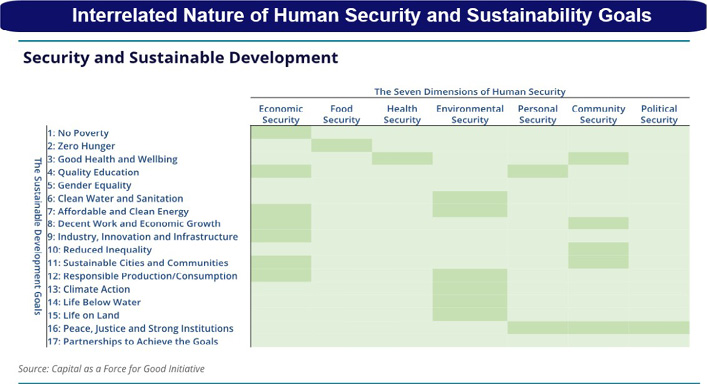
Human Security is conceived in terms of eight interdependent dimensions—food, health, ecology, economy, technology, politics, community, and individual security. These dimensions largely coincide with the 17 Sustainable Development Goals. Human Security is a comprehensive umbrella that encompasses them all. It is the cross-cutting theme that connects them all together.††††
"WAAS seeks to evolve from an intellectual think tank into an impactful organization with the capacity to effectuate concrete changes in the world at large. Our aim is to ensure a better future for all. Human Security for All provides us with the overall framework, direction and perspective true to the Academy’s founding vision."
Agenda 2030 and Human Security are complementary approaches to address these global challenges—the former from the top-down global perspective of science and governance, the latter from the bottom-up perspective of every individual and community. The SDGs are an expression of the organized political will of humanity to work collectively to address their common problems. Human Security represents the collective aspiration of billions of people for a secure and sustainable way of life for everyone on Earth.
The Academy’s challenge today is to continue the shift from understanding to action. This shift calls for a fundamental change in the way we think. It calls for effective measures to fully engage the wide-ranging potential of the Academy’s membership to approach global challenges from a comprehensive, integrated, transdisciplinary, transnational, human-centered, values-based perspective as initially envisioned by our founders. It will require reframing our knowledge within a comprehensive, integrated theory of social development and evolution based on fundamental advances in our way of thinking and concept of knowing that integrate the objective insights of the sciences with the subjective perceptions derived from the arts and humanities.
Our objective is to elevate the fundamental values of humanity, fostering global peace, promoting global citizenship, reorienting education towards the acquisition of integrated knowledge, offering values-based scientific knowledge and wisdom to advise policy and decision-making, and combat the threats of disruptive technology. With a clear action plan to achieve measurable outcomes, WAAS seeks to evolve from an intellectual think tank into an impactful organization with the capacity to effectuate concrete changes in the world at large. Our aim is to ensure a better future for all. Human Security for All provides us with the overall framework, direction and perspective true to the Academy’s founding vision.
4.5. Strategic Rationale for HS4A
Following robust debate on the topic by the Board of Trustees, the wording and objectives of ‘human security ’ and ‘human security for all’ have been adopted as a program framework for the work of the Academy for a number of reasons:18
- Global Relevance: It addresses the highest priority needs of the whole world community
- Complement to SDGs: It is a catalytic strategy for achieving Agenda 2030 that complements the top-down, global approach of the 17 SDGs with a person-centered, context specific approach related to the needs and well-being of individuals and communities.
- Inclusiveness: Its inclusive scope and direct relevance to virtually all of the program areas WAAS has been focusing on, from war, nuclear weapons, climate, economics, finance and environment to education, employment, energy, food, health, the social relevance of basic scientific research, business, technology, AI and all types of existential risks.
- Support for Multilateralism: It seeks to build broad-based public support for the efforts of UN agencies to address major global challenges on behalf of all humanity.
- Building Networks: It is dramatically expanding the reach of WAAS by helping us forge active partnerships with UN agencies, governments, international organizations, science academies, universities, NGOs, faith-based groups, business and finance, environmental and youth groups.
- Integrated Approach: The campaign strategy is based on a human-centered, transdisciplinary, integrated approach that bridges gaps and missing links between disciplines and between research, policy, implementation and social impact.
- Public Awareness: HS4A has generated unprecedented visibility for WAAS in terms of mainstream press & social media coverage.
- Opportunities for Impact: HS4A has opened up opportunities to transition from campaigning to education, training, policy-making, and other impact initiatives in collaboration with the UN and other partners.
- Fundraising: HS4A enhances the credibility, eligibility and capacity of WAAS to raise funds.
With this history and in this context, the WAAS Board of Trustees initiated a Strategic Planning Process (SPP) in August 2023 with the objective of developing a plan for the future development of the Academy for the remainder of this decade. The decision was followed by a survey of WAAS Fellows in October 2023 to seek their views, suggestions and proposals regarding the Academy’s present functioning, current direction and future potential. Based on feedback from the survey and from interviews with all members of the Board, a three-day meeting was conducted at the Academy of Athens, Greece in November 2023 to consider the first outline of a strategic plan to guide the work of the Academy over the next five years.
An important initial step in the planning process was to assess the current capabilities and limitations of the Academy. The WAAS Board agreed that the first priority should be placed on maximizing utilization of existing capacities and resources, by engaging and mobilizing the rich diversity of its members’ expertise and experience and by extending and multiplying the Academy’s growing network of partnerships with UN agencies, governments, research institutes and academies, universities, NGOs, youth groups, businesses and the media. At the same time, it is evident that successful expansion of its program of work will require significant strengthening of its organization through the recruitment of full-time staff to complement the voluntary contributions of members, developing an effective fundraising program, and strengthening external communications.‡‡‡‡
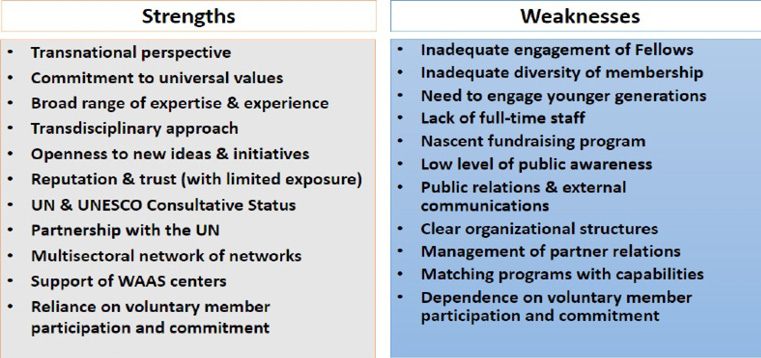
5.2. Vision of Future WAAS
The SPP meeting in Athens examined the founding vision and mission of WAAS, reviewed recent developments, discussed current and proposed programs, and took decisions regarding further steps needed to continue work on the strategic plan while initiating essential measures already approved by the Board. The emerging vision of the future WAAS has the following characteristics:
- An agency dedicated to human security, human welfare and sustainable development for all
- An organization of individuals representing excellence in art, science and professional fields of accomplishment
- Seeking to embody the values, vision, commitment and the social responsibility of science as represented by our founders
- Seeking to provide Leadership in Thought that leads to Action to address the vital problems confronting humanity to promote human security for all
- Striving to think on behalf of all humanity from transnational, transdisciplinary, non-partisan, unbiased, multi-cultural perspectives
- To be a catalyst and engine to complement, supplement, support, and extend—but not to replicate—the work being done by others.
- WAAS was founded to bring a message of hope after WWII. Today WAAS can play a similar role, with AI focused on its benefits to humanity, rather than power and profit.
- How do we individually embody these principles?
- How do we demonstrate them collectively as an organization?
- How do we disseminate them in all that we do?
- How can WAAS guide humanity towards its highest level of aspiration and self-actualization?
- Education for Human Security and Sustainable Development: In order to prepare youth to be informed, competent and successful citizens in a world that is emerging, all students, regardless of their fields of study or social aspirations, need to be exposed to a core curriculum of knowledge on all dimensions of human security, including environment, technology and health. A conference conducted by WAAS and WUC in 2023 involved experts from more than 20 disciplines, including natural and social sciences, law, business, engineering, and the arts. The conference highlighted the potential of innovative strategies in every field of instruction to explore the relevance and importance of all dimensions of human security to all disciplines, including the full range of natural and social sciences, technology, law, medicine and humanities. This includes the media, cinema, literature and the arts which possess the greatest effective power to inform and motivate individual and collective action to address these challenges.
- Transdisciplinary and intersectoral Education
“ We are in an age that assumes the narrowing trends of specialization to be logical, natural, and desirable. Humanity has been deprived of comprehensive understanding. Specialization has bred feelings of isolation, futility, and confusion in individuals. Specialization breeds biases that ultimately aggregate as international and ideological discord, which, in turn, leads to war” – Buckminster Fuller
The quest to transcend disciplinary boundaries in search of more universal principles governing the interdependencies between fields and phenomena is far more advanced in the natural sciences than in the social sciences which grapple with more complex phenomena where the silos remain largely intact. WAAS and WUC have already explored the possibility of developing original knowledge content addressing transdisciplinary subjects of immensely important and potential intersectoral application. Subjects of immense practical relevance such as social power, insight, intuition, individuality, life knowledge, and creativity transcend the boundaries of conventional academic subjects, theories and research. Of these, efforts to evolve a coherent theory of change or evolutionary theory of social development represent the social equivalent of the quest of physics for an ultimate theory unifying relativity theory and quantum mechanics.†††††††††† Priority should be given by WAAS and WUC to support new thinking, research, course development, delivery systems in these and related fields to enhance the focus on transdisciplinary perspectives in education.
- Social impact of Business and Technology: WAAS was founded by eminent scientists in an era when science was just awakening to the enormous power and responsibility it had for the impact of advances in knowledge on the security, welfare and well-being of society. The idea that these outcomes are someone else’s business has been discredited long ago, but the tendency to divorce activity from social consequences is still widely prevalent in all fields. In a similar manner business and technology education largely ignore the social impact and social mission of their activities and the essential social role they play as instruments for human welfare. At an IEEE international conference on AI and cognitive computing a few years ago, leading experts conceded that current education in AI and related fields of technology focuses almost exclusively on technical knowledge and skills, and barely at all on equipping students with the knowledge needed to understand the potential benefits and threats posed to society by application of these technologies. The advent of generative AI has propelled this issue into the limelight globally for technology leaders, but the same sense of responsibility is relevant to all fields. The growing awareness of the importance of measures such as ESG (environment, social, government) in business and finance is a welcome recent trend, but it is primarily due to necessity rather than arising from a deeper appreciation of how central these values are to the long-term viability and flourishing of businesses and society. Content and courses focused on values, impact, policy implications related to all dimensions of human security and all fields of study need to be developed and disseminated globally.
- Trauma Informed Care Best Practices: The costs of emotional trauma were staggering well before the COVID-19 pandemic and with increasing conflicts now, the worldwide burden of trauma has doubled. The costs of trauma are systemic, trauma damages individual and social health and if untreated may be passed to the subsequent generations. The Trauma Informed Care Best Practices (TIC- Project) is a network of networks created to provide free training, materials and information to people and organizations dealing with relevant issues related to psychological trauma.‡‡‡‡‡‡‡‡‡‡ It supports, connects and assists all the professionals and public and private organizations operating in countries ravaged by violence and disasters that are in one way or another dealing with people who need to be trauma informed. Since its launch there have been numerous demands for extending the program to other regions. TIC Best Practices are scientifically sound procedures that avoid the risks of re-traumatization and can facilitate growth from trauma. The TIC Project aims to educate, train, support and empower for free all the different stakeholders around the world: thanks to the knowledge acquired, these therapists will be better able to apply its principles in their area of work. This is a model with a vast potential that needs to be scaled up and extended globally. With the spread of warfare throughout the world, this is a program that needs to be institutionalized and implemented widely.
- AI for Education: The efficacy of online education has always been hampered by the limited ability to provide personalized attention and guidance to each student, a problem that prevails in traditional classroom education as well, though to a lesser extent in elite institutions with very small class size. Recent developments suggest that adoption of generative AI can provide the technological basis for interactive, self-paced, customized, individualized learning systems at low cost for students at all levels of education in all languages. This will provide students with an extraordinary capacity to seek information, raise questions, test their knowledge, and explore topics of personal interest.
Development of generative AI programs for personalized, interactive, self-paced learning in all fields of education will provide strong support needed for the evolution to a more person-centered pedagogy and facilitate the transition to life-long learning.
- Development of higher order mental capacities and creativity: Before the advent of the printing press, those who could read and write were often regarded as geniuses. Much attention has been directed at the threat posed by AI to jobs as the growth of memory, data processing capabilities, language and sensory skills continues to develop exponentially. Every advance of technology has either eliminated or reduced the hardship associated with human labor, resulting in a migration of labor from jobs involving physical danger, drudgery or unthinking repetitive work to enhance their skills and migrate to work requiring higher order mental and emotional capabilities. The notion that AI will eliminate both present and higher order work opportunities for human beings grossly underestimates the scope for the further evolution of human capacities beyond the types of work that predominate today. Research is needed to identify the higher order knowledge, mental and psychological skills that characterize the work of high performing leaders, thinkers, performers, creative artists, inventors and even genius. Methods can be framed to systemically develop what are widely regarded as unique capabilities in these and other categories of people. Intuition ranks among the highest of these faculties.
- AI, Mind and Consciousness: Advances in AI have renewed debate within and outside the AI community regarding the nature of the processes responsible for the remarkable results generated by recent breakthroughs in AI and the similarities and differences by computer responses, the processes governing thinking in the human mind, and the presence and nature of consciousness in AI and human systems. There is widespread debate and disagreement even within the scientific community as to whether computers think or possess consciousness or will ever be capable of either. These issues may prove to have considerable importance in understanding and developing both computers and human beings, but they test and transcend the limits imposed by modern science, both in terms of its fundamental premises and methodologies. A subject which transcends the limits of objective physical science necessitates reference and consideration from the perspective of other dimensions of knowledge, namely the subjective dimensions of human experience including the arts, humanities and other forms of creativity and enlightenment. A better understanding of the similarities and differences may play a vital role in determining the human response to technological advances as well as humanity’s understanding of itself and its own unique capacities for evolutionary advancement.
- Rationality, Imagination and Creativity: Imagination and creativity are powers common to science, the arts and other fields. They mark the point at which the mind transcends the lofty limits of logic, rationality and pure reason. From Socrates, Galileo, Newton, Einstein and beyond, all discoveries depend on imagination and creativity that our education systems should encourage. The role of religion and traditions is central to this theme. Still these faculties are not understood and are regarded as lying outside the conventional domain of education. A transdisciplinary exploration of these phenomena and the circumstances in which they manifest can provide insight into ways to consciously energize and develop them.
- Insight and Intuition: As Einstein observed, “It is not intellect but intuition which advances humanity.” Intuition tells man his purpose in this life. A host of other great scientists, philosophers and creative thinkers have also testified to the fact that their greatest achievements were the result of intuitive insight rather than logical mental processes. Yet in spite of abounding evidence, insight and intuition are regarded as gifts that cannot be acquired by learning. Research needs to be conducted to study the processes of insight and intuition and to evolve methods to consciously foster development of this higher order mental faculty.
- Transnational: Addressing global social challenges
- Human-centered: Promoting peace, human rights and human security for all and impacting on them
- Values-based: Highest ethical standards promoting universal human rights
- People-centered: Empowering people and communities, fostering creativity and resilience
- Transdisciplinary and trans-sectoral: Harnessing the richly diverse expertise and experience of WAAS Fellows to explore the interrelationship and interdependencies between disciplines.
- Sustainable: Intentionally becoming part of the solution of the Anthropocene quagmires
- Engaging: Mobilizing the rich and diverse capacities of WAAS Fellows.
- Networking: Forging productive collaboration with other organizations with complementary capabilities for maximum reach and impact.
- Affordable: Fundable projects that maximize use of existing WAAS resource capacities and those capable of attracting additional resources.
- Impact: Addressing all stages of the process from formulation of ideas, theories and research, to policymaking, strategy, organization and implementation and social impact.
“We are not a scientific organization but an institution committed to the highest universal values that promotes and uses scientific knowledge for the survival, security, welfare and wellbeing of humanity.” - Ivo Slaus, WAAS President (2011-’13)
During the Athens meeting, the Board confirmed the decision that human security represented a comprehensive, inclusive framework encompassing the full gamut of issues central to the future welfare and well-being of humanity and the sustainable development of the environment supporting all life forms on the planet. The Board also decided that it was time for a shift in emphasis from preoccupation with the conceptual exploration of the issues that have preoccupied WAAS for the past decade to a focus on efforts to apply the knowledge and insights in order to achieve practical impact in the world.
Already initiatives are underway to apply the principles of human security to the management of technology, training and influence of policy-makers, revamping of educational curriculum, and mobilization of civil society to address a wide range of social issues through education, training, public policy, institutional reform and building broad-based public support. The shift in focus in WAAS programming to application and impact must now be magnified, extended and accelerated.
At the same time, the Board recognized the need for very significant efforts to enhance and accelerate the conscious evolution of WAAS. It identified areas in the Academy’s administration and management that require strengthening as well as potential opportunities for future programming.
Among them are the need to expand, diversify and enhance the breadth and depth of expertise among WAAS membership, encourage Fellows to more actively contribute to the Academy’s future work, expand and diversify programming, improve internal and external communications, launch a professional fundraising campaign to support new programming and organizational development, and recruit paid staff to support programming, fund raising, internal and external communications. Special emphasis was placed on programming with concrete, measurable impact. These issues are now under study and will be taken up for action during 2024.
In order to expand the scope of membership awareness, engagement and participation, the Board also decided to conduct WAAS@64, an online conference and general assembly in mid-2024, similar in character and scope as the WAAS@60 conference in February 2021. The 2024 event will provide opportunities for direct communication and discussion among WAAS Fellows on strategies and programs for inclusion in the new strategic plan.
6. Future Programming Opportunities
The Athens meeting also included a presentation on ongoing and proposed activities that have already been identified and are consistent with the mission, goals and objectives of WAAS. The remainder of this paper briefly describes the most salient of these activities which will be further developed and discussed at the WAAS@64 conference and in other fora.
In 2024 the HS4A project will shift focus from communications to impact by leveraging the relationships forged by the Academy during the first year of the campaign. Among them are initiatives already described above involving practical measures to engage the global community of business and technology leadership through CES 2024 and F4G; engagement with scientific research institutions through collaboration with IAP; training of parliamentarians through collaboration with IPU; outreach to decision makers, social media influencers and the general public via the arts, cinema and social media; introduction of year-round course content covering the full range of human security issues for children at different ages in schools in India; and extension of the Academy’s research network through expanded partnerships in different sectors of society.
6.2. Human Security Concepts and Measurement
The introduction, monitoring and implementation of the SDGs within the UN 2030 Agenda are inherently related to the concept of Human Security and its components. Measurement is essential for the effective assessment and evaluation of policy measures. Developing an effective set of indicators to assess levels of attainment for all dimensions of human security should be given high priority. The “Cross-Country Metrics for Comprehensive Human Security Assessment” project, launched by WAAS partner AE4RIA, aims to develop standardized cross-country metrics to assess human security across nations to enhance global understanding and facilitate informed policy decisions.20 WAAS also conducted a webinar in June 2023 which included project leader Phoebe Koundouri, Jeff Sachs and other members of the project team.21 The model they developed clearly shows the correspondence between human security goals and the 17 SDGs. Plans are underway to fully develop and apply measures for human security at the global, regional and national levels and, possibly also, at the corporate level, similar in nature to those already developed for the 17 SDGs. Other opportunities to extend the reach and impact of HS4A discussed in Athens are briefly described below.
6.3. Human Security – Education Upskilling and Reskilling§§§§, ¶¶¶¶
Mainstreaming Human Security concepts in Higher Education and Policymaking is essential for achieving the goals of sustainable development. WAAS supports the SDSN Global Climate Hub’s Unit (GCH): Education, Training, Upskilling and Reskilling.***** The SDSN GCH, chaired by Phoebe Koundouri, has made it its mission to provide science-based recommendations for combating the climate crisis and preventing further deterioration. Its research teams work on the development of cutting-edge models for all major natural and infrastructure systems (e.g., climate change, water, atmosphere, land-use, food, energy, transport, marine-use systems, etc.), supported and connected by a powerful digital AI-driven infrastructure. These are put into the proper socio-economic context, through overarching economic models for the case study/ application of interest.
The GCH provides regional, national, and sub-national pathways for the transition to a climate-neutral and prosperous world. The pathways are practically optimal, dynamic mixtures of technical, engineering, technological, policy, fiscal and financial measures. These are co-designed by research teams holding the scientific expertise and model-driven information, and local stakeholders, through transformative participatory workshops. Thus, co-owned solution pathways are implemented. The whole process is based on Open Science, making data and models accessible to everyone.
SDSN GCH can help countries achieve sustainability against the backdrop of interconnected, complex challenges.††††† The 9 Units of the SDSN GCH represent the stages that a country should go through in order to achieve the design and implementation of detailed climate neutrality and climate resilience pathways. In this direction, there are plans for Amanda Ellis, together with Phoebe Koundouri and SDSN GCH, to deliver seminars to Parliamentarians across the globe targeting the upskilling and reskilling of the Public Administration Sector and governments.
6.4. Technology as a Force for Good
WAAS collaboration with Force for Good (F4G), a WAAS strategic research partner, has been one of the highlights of the HS4A campaign. The release of two reports on Technology as a Force for Good by F4G at CES 2023 and 2024 highlighted the indispensable role of technology for achieving the 17 SDGs and the goals of HS4A and provided a practical means by which the Academy could seek to exercise real impact on an issue of central importance. Technology is a double-edged sword and represents both unprecedented threats and opportunities. But without the support of technological innovation, it will be extremely difficult to meet humanity’s aspirations as set forth in Agenda 2030. The F4G research documents the enormous untapped potential to develop and apply innovative technologies to enhance human security in all major dimensions, sectors and parts of the world. In 2023 HS4A and F4G campaigning raised awareness of the importance of technology, and we were pleased to see the UN recognize technology as an eighth dimension of human security, which prompted CTA to adopt HS4A as the theme of CES two years in a row, the only two occasions that a theme has been adopted for CES in a half century of exhibitions. These reports created greater access and impact for our work with CTA/CES and forged active relations with the United Nations Secretary General’s Special Envoy for Technology.
The 2024 F4G report on technology reports:
Existing technologies enabled by AI can close nearly 50% of the gap if scaled and deployed globally, and can help position the world in a more risk managed manner for the transition to the Information Age. The leading three critical initiatives that lay the foundations for achieving the SDGs and effectively levelling up the world are universal connectivity, leveraging generative AI across the SDGs, and mass financial inclusion.‡‡‡‡‡
One component of the F4G research focused on the dramatic impact of financial technology on providing access to bank accounts, bank credit facilities, government incentives and insurance for 500 million Indians. The F4G initiative worked with the Government of India to promote the idea that offering its fin-tech platform and solutions free of charge to other countries would drive global financial inclusion to the benefit of the world, especially the Global South and India. The Indian government, in its G20 leadership year, hosted an event in April 2023 at the UN, in the ECOSOC chamber, to discuss their technology and offer it to the world with representation from the UN, the Indian ambassador to the UN and F4G. The report also identifies five other pivotal SDG high impact areas which also have enormous transformative potential: affordable housing, mass education, impact on the individual, biodiversity and impact externalities.
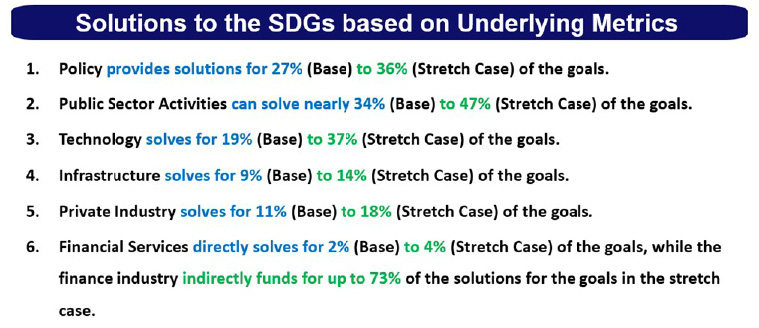
In addition, F4G’s 2023 report on capitalism for a secure, sustainable and superior future extended the analysis to identify 15 solutions that could together address 70% of the SDG gap. Among these the greatest impact could be achieved by a green transition policy framework and sustainability disclosure standards. The report concluded that policy solutions alone could provide solutions for 27% to 36% of the SDG gap and public sector activities such as environmental impact bonds and debt for nature swap could provide an even greater amount. Combined, all the potential levers, if applied could still enable us to fully achieve Agenda 2030 within the original timeframe. The report also identified six high-impact transformational initiatives, including affordable housing, mass education and mass financial inclusion. This research transcends the analysis, commonly focusing almost exclusively on financial resources. They suggest tapping into untapped potential for other impact initiatives.§§§§§
WAAS and Force for Good are committed to identifying other untapped technological and financial opportunities and practical strategies for business, research and government to close the SDG gap and enhance human security all over the planet.¶¶¶¶¶, ******
6.5. Science, Sustainable Development & Human Security
Aligning scientific research with the unmet needs of society is essential for achieving the goals of human security and sustainable development.
WAAS is in the process of organizing a series of events devoted to the role of science in achieving the goals of sustainable development and human security. The first event was the World Conference on Basic Sciences for Sustainable Development, held in Belgrade, Serbia on September 19-22, 2022.†††††† That was the flagship event for Europe within the International Year of Basic Sciences for Sustainable Development (IYBSSD), proclaimed by the United Nations General Assembly (UNGA) in December 2021. Besides WAAS, UNESCO and The Club of Rome were among its organizers. The main conclusions of the event were that without an adequate investment in basic research as the initial link in the chain of research and development, it will not be possible to find the proper path towards the inclusive, balanced, and sustainable development of the planet, and that reaching these goals requires a full multidisciplinary involvement of all sciences, i.e., basic, applied, social, and humanistic ones. The main result of the event was the proposal to the UNGA to proclaim the period 2024-2031 as the International Decade of Basic Sciences for Sustainable Development (IYBSSD). The proposal was approved, and the Decade was proclaimed by the UNGA in August 2023.
The Belgrade conference was followed by two webinars: WAAS Talks on Science for Human Security: Biohydrogen Production and Use, held in June 2023, focusing on the future potential of clean hydrogen fuel in the transition from fossil fuels, and WAAS Talks on Science for Human Security: Science Diplomacy, held in October 2023, examining the three pillars of science for diplomacy, and in diplomacy, and the use of diplomacy to facilitate scientific cooperation across borders.
The initial version of the WAAS Program of Sciences for Sustainable Development was launched in November 2023 for inclusion in the overall program of IYBSSD. The program continued the series of WAAS Talks on Science for Human Security with Nature-Based Climate Control on February 28, 2024, followed by future webinars on Artificial Intelligence, Nanomaterials, Healthy Ageing, Fusion Energy, Social Inequalities, Sustainable Cities, Multilateralism, Green Transition, Ecological Anthropology, Cultural Architecture, Science and Art, etc. The Program will also include the World Conference on Science and Art for Sustainability, on September 22-25, 2025 in Belgrade, and the World Conference on Big Science with Accelerators: Basic Sciences and High Technologies, in June 2027.
The plan also includes a few platforms in science and technology for cooperation between the Global North and the Global South, functioning through bilateral and multilateral cooperation agreements between the involved international, regional, and national scientific and educational organizations. A number of such agreements have already been executed and are being implemented; including the themes Big Science with Accelerators, Food, Water, and Energy Security, and Big Science in Space. The Program will be implemented together with interested international, regional, and national non-governmental organizations, private sector entities, and individuals in coordination with UNESCO, other relevant organizations of the UN system, and some governments. All the activities within the Program will be focused on policies and regulatory measures with the aim of concretely contributing to achieving sustainable development and human security at the national, regional, and international levels.
These activities may include collaboration with universities, research laboratories and networks such as the International Universities Climate Alliance, the Earth League, the Earth Commission and the New Carbon Economy Consortium.
6.6. From Atomic Energy to Artificial Intelligence
The discovery and harnessing of atomic energy led to the recognition of science and technology as a double-edged sword with unrivaled power for social advancement or destruction. The Manhattan Project gradually led scientists to the realization that they could no longer live in ivory towers occupied with fundamental research that might someday be converted into technologies to promote or threaten human security and life on the planet. The founders of the Academy lived and worked through the period when this realization gained widespread prominence and WAAS was established to cope with the ethical and practical implications of this discovery.
At the end of the Cold War, it was hoped by many that the nuclear age would fade into the past and weapons of mass destruction would be completely eradicated. Indeed, progress was made to reduce the total number of warheads by 80% and remove the rest from critical alert status. Yet, in spite of ardent efforts by the Academy’s early leadership to contain and place atomic energy back inside Pandora’s Box, nearly eight decades later, humanity still confronts the dilemma of how to contain and protect itself from the consequences of its own discoveries. Today we witness once again the specter of these weapons and a renewed assertion of their power.
By a strange irony, at the very moment when the threat of nuclear weapons has once risen into prominence, Artificial Intelligence has suddenly emerged as another double-edged sword with unprecedented power for creative and destructive purposes. Once again, we confront the dilemma arising from the power of knowledge to be used to dramatically enhance the security and well-being of humanity or to undermine it.
Today the same debate is preoccupying the minds of leading scientists and engineers, corporate leaders, politicians, and diplomats regarding the lightning-fast development of AI.‡‡‡‡‡‡
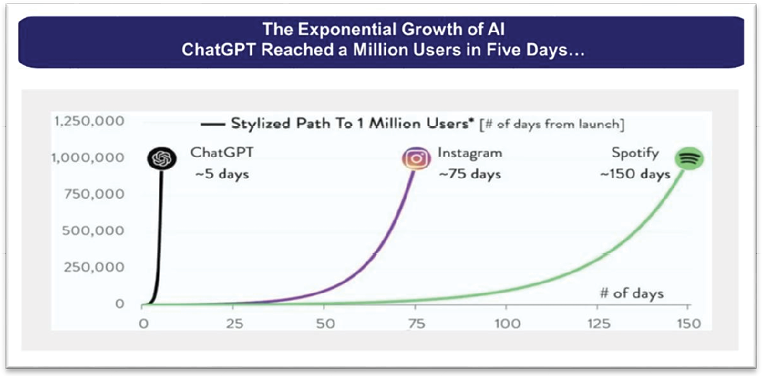
How do we contain the potential threats and harness the beneficial powers of technology for the common good and human security for all?
“The tempestuous technical development tends to throw mankind off its psychological equilibrium and possibly even to destroy it physically. Only far-seeing statesmanship in cooperation with the leading scientists in all branches of science will be able to regain the equilibrium. It will be one of the main tasks to bring such a cooperation into being.” (First International Conference on Science & Human Welfare, Wash. DC. 1956)
Recent events remind us that the discovery of knowledge is not sufficient in itself. We must also accept responsibility for how it will be utilized. At a time when we are still grappling with the consequences of renewed military conflict, we must also confront and cope with an explosion of technological developments and deployments whose ultimate character and consequences are unknown and whose governance presents a challenge even greater in scope and complexity than the threat of nuclear weapons ever presented. The future security of humanity will depend on how we respond to this challenge and if we are able and willing to develop people-centered, safe and sustainable innovations.
6.7. AI Governance for Human Security
AI ranks at the top of the list as a potential force for good in the world as well as a growing threat to all dimensions of human security. Already, important breakthroughs have been achieved by the application of AI to abridge the time required to design new drugs such as a vaccine for COVID-19 as well as a variety of new materials. According to research at Morgan Stanley, even modest improvements in early-stage drug development success rates enabled by the use of AI and machine learning could lead to an additional 50 novel therapies over a 10-year period.§§§§§§ AI’s enormous potential for transforming global education is discussed later in this paper.
The potential threat posed by the misuse of AI also ranks at the top of the list along with climate change and atomic weapons as an issue of vital importance to all of humanity. Governance of AI at the global level is essential to encourage the development of AI’s positive potentials while at the same time preventing wrong applications.
The need for AI governance is multiplied by the prospect of the rapid development of AGI (Artificial General Intelligence or Super Intelligence) which exceeds the intelligence of human beings. AGI could pose existential risks to civilization as we know it. It also has the potential to positively address the full range of human security threats and vastly accelerate the evolution of global society. Research by WAAS partner Millennium Project identifies the complex factors which make monitoring and governance of AI far more difficult than those posed by nuclear weapons. The chart below compares the potential threats arising from AI and AGI.¶¶¶¶¶¶
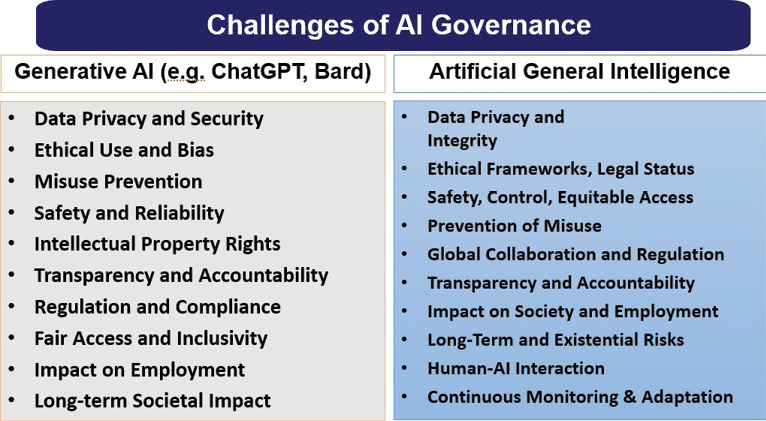
As the founders of WAAS recognized the pressing need for global governance of nuclear energy at the very moment it was developed, today the Academy views efforts to promote effective governance of AI and AGI for the welfare of humanity as among the highest priorities for WAAS and the world. WAAS has already been invited to collaborate with UNESCO and other partners in this endeavor.
6.8. AI, Media & Human Security
“Europol, the European Union’s law enforcement agency, predicted that as much as 90 percent of content on the internet could be created or edited by AI by 2026.” – Gen.ai *******
“We are witnessing a pivotal moment where the adversaries of democracy possess the capability to unleash a technological nuclear explosion… their weapons of choice are misinformation and disinformation, wielded with unparalleled intensity to shape and sway the electorate like never before.” – AI2 †††††††
“We always overestimate the change that will occur in the next two years and underestimate the change that will occur in the next ten. Don’t let yourself be lulled into inaction.” – Bill Gates 32
The topic of fake news and information disseminated through mainstream and social media reached the headlines during the 2016 and 2020 US presidential elections and spurred many initiatives to address it, though none appeared adequate to quell the surging place of disinformation in politics and other fields. A special session conducted at GL-2020 tried to explore and find a solution to this issue but was unable to arrive at an adequate response.‡‡‡‡‡‡‡
In 2024 nearly half of the world’s people will go to the polls to vote, making this a critically important year for global democracy. The rapid spread of disinformation poses a very serious and ever-growing threat to the viability of democracy and human security. The increasing use of the media to disseminate inaccurate and fake news is undermining the quality of decision-making, public opinion, and political outcomes. This trend is further aggravated by the increasing resort to social media as a major news source, especially among younger generations. Studies indicate that the reliability of information on social media ranks the lowest of all major news sources. Moreover, recent developments in AI make it possible to vastly facilitate the falsification not only of news reports but of video content cited as evidence.
Already numerous initiatives are underway by media leaders and other organizations to address the threat posed by fake news, such as a global registry of labelled fake news, fact checking mechanisms and AI and data-driven platforms to develop automatic fake news detection systems. Human intervention cannot possibly deal with the magnitude of global information flows. But recent breakthroughs in generative AI may now make it possible to harness the power of AI to counter the use of AI for falsification of information. WAAS is examining possible organizational and technological mechanisms to mitigate the falsification of information disseminated through the media.§§§§§§§
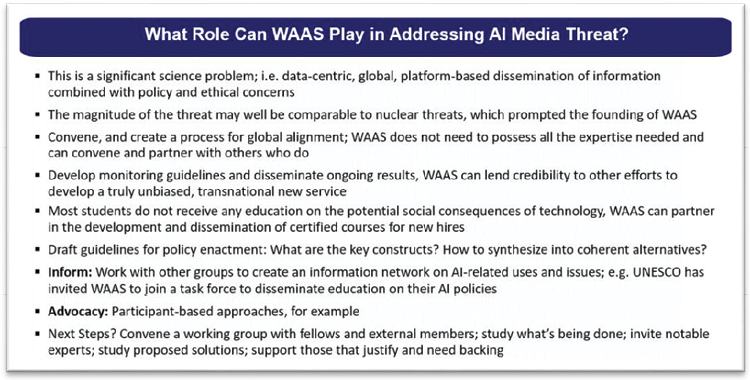
6.9. Existential Risks & Human Security
The WAAS Existential Risks to Human Security Working Group (ER2H) has been studying the full range of serious challenges, risks and threats posed by existing and potential existential risks to world peace, democracy, environmental stability and human security. It is also working on a strategic approach for addressing these risks so that it can focus on solutions as well as threats. Plans are under preparation to establish a Global Futures Platform for the planet, people and peace. This platform would adopt an integrated approach, enhance capacity through education and workforce development, share knowledge and technological solutions as global goods, strengthen leadership skills, and enable good governance. An international transdisciplinary education conference focusing on solutions to existential risks has been proposed as part of the Group’s activities.¶¶¶¶¶¶¶
A High-Level Meeting to strengthen global governance for existential threats was convened by the InterAction Council and One Young World at the House of Lords in London in January 2024. The purpose of the meeting was to outline a process and a plan through the creation of an intergenerational Global Security Council for Existential Threats, responsible for the design and delivery of a strategy and action plan.
Follow up actions will be further advanced at the InterAction Council plenary in the spring of 2024 which is planned to be hosted by China. Next steps outlined at the meeting include inviting members to the first intergenerational meeting of the Global Security Council for Existential Threats. This will be combined with a series of High-Level Expert Meetings to formulate a living strategy supported by the development of committees that coordinate actions. Committed partners are already working together to advance an advocacy campaign and a digital platform for the Planet, People and Peace. Jo Nurse, The InterAction Council advisor, and Chair of the World Academy of Art and Science’s working group on Existential Risks for Humanity (ER4H), welcomes further engagement with partners.********
6.10. Climate Threat
The rapidly escalating climate crisis threatens to destabilize on every level. 2023 set another record on extreme heat and for the first time, the 1.5 degree threshold in the Paris Accord was breached in terms of average temperatures for the year through January 2024. As oceans icon Dr Sylvia Earle points out, “This decade is the most decisive in the next 10,000” for the health of our planet and all the life forms it supports. We have a rapidly narrowing window of opportunity to take radical action and hence WAAS has a critical role to play in addressing all dimensions of this existential threat. While the science is clear and solutions largely exist for immediate action, the sociological and political dimensions of the climate crisis are complex. Those with vested interests have been slowing down the transition away from fossil fuels urged in the COP28 outcome document and spending vast sums annually on disinformation and political advocacy to maintain the status quo.
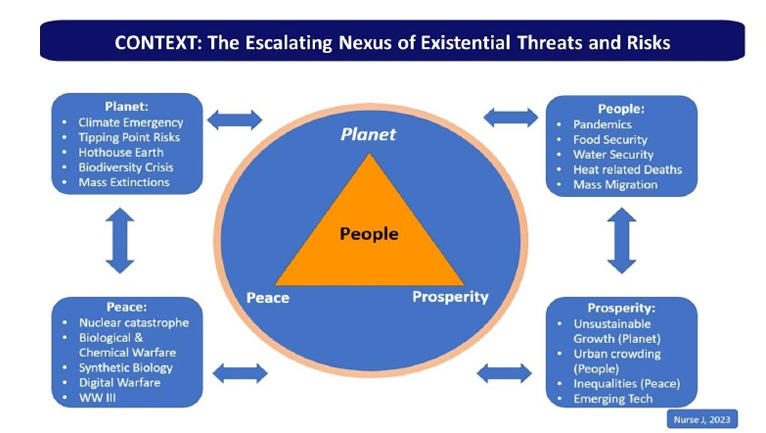
So instead of positive progress and aligned incentives, the IMF points out fossil fuel subsidies have reached record highs: $7.1 trillion in explicit and implicit subsidies in 2022. If these subsidies were to be removed, the IMF estimates a drop in emissions of some 34pc by 2030 - three quarters of what scientists say is needed. Hence our ability to communicate with and help influence Parliamentarians is critical. It is Parliamentarians who legislate to turn the Nationally Determined Contributions of the Paris Accord into national law, oversee budgets and hold to account their own governments and other UN members on their Greenhouse Gas reduction commitments.
WAAS proposes aligning with and cross promoting the current climate educational work with the Inter-Parliamentary Union, the Commonwealth Parliamentary Association and global policymakers, led by WAAS Board member Amanda Ellis at the ASU Julie Ann Wrigley Global Futures Laboratory and the proposed partnership with the SDSN Global Climate Hub led by WAAS Board member Phoebe Koundouri.††††††††
WAAS Fellows can be invited to join the “Ask an impartial expert” function to help provide Parliamentarians and policymakers with impartial advice.
There are of course important intersections with the other existential threats discussed in this paper which WAAS proposes to address regarding both AI and disinformation that can be highlighted across all three projects.
6.11. Global Voices for Human Security
Global progress is stifled by the resistance and vested interests that retard development of the multilateral system. It is also limited by the lack of awareness, engagement and communication between policymakers and the global public. In addition, there is little or no statistically reliable information about the actual views of the public on most issues.
The GL-21 project concluded that mobilizing the voice of global civil society is a force that can alter the balance of power and accelerate progress to transform prevailing institutions and policies of global society. In response, WAAS and F4G are examining ways to exploit the power of technology, including blockchain and AI, to magnify and multiply the voice of the global general public. The objective of the project is to keep people reliably informed and interconnected by adding value to their lives. Over time, it could serve as a non-legally binding “global referendum” platform and become a powerful voice to influence decision-makers.
The project envisions creation of a global platform where everyone can express themselves on issues of critical importance to humanity in order to build global support for a global social movement. This platform would abide by human rights declarations, engage the public, and become a global voice.
Through value generation, social media engagement, gamification, online collaboration and innovative use of AI and collaborative technology, a platform of this type could have a significant positive impact on global society.‡‡‡‡‡‡‡‡
The project raises many complex issues relating to engagement, outreach, confidentiality, reliability and authenticity of inputs. The platform would adopt a liquid democracy design independent of elected authorities and institutions. It could be utilized to conduct opinion surveys and research projects, disseminate information, facilitate discussion, and conduct polls or referendums of the world’s peoples. Technology could be employed to ensure the uniqueness and privacy of participants to the extent of requiring each participant to utilize a mobile phone number. Force for Good is already experimenting on early prototype models of such a platform and examining various technological solutions. See§§§§§§§§
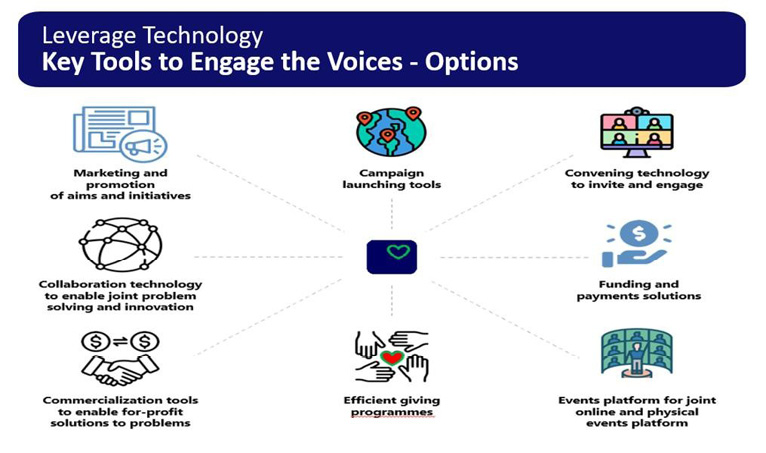
If effectively established, it could become a very valuable source of information for governments, researchers and opinion-polls, providing a much clearer understanding of global public opinion as well as feedback to the public regarding prevailing beliefs, views, ideas, and attitudes. The project would require partnerships providing the required investments, sophisticated technical design, and operational management. The value of the system would depend entirely on its credibility as an impartial, transnational representative of global society. The involvement of WAAS in some capacity, either on its own or as part of a consortium of qualified partners, would be intended to primarily instill public trust and confidence regarding the impartiality of the platform and its efforts to present unbiased, fact-based information.
WAAS is collaborating with F4G to work out the technical and financial requirements for such a project, harnessing the power of AI to vastly enhance its effectiveness.¶¶¶¶¶¶¶¶
Role of Culture in Human Security
Culture is the bedrock of relationships between people near and far and human security is a function of culture. The extremely rapid development of technological innovation and application spreading the world far outpaces the slow, haphazard and evolution of social cultures at the local, national and global levels. The gap between technological revolution and cultural evolution is a major source of the growing sense of uncertainty, insecurity, and resistance to change that is spurring the polarization of societies and rising levels of violence within and between nations. Scientific and technological progress cannot be stopped or slowed down, but they can and must be analyzed from the point of view of their ethical and social impact and consequences. Human Security founded on cultural understanding and harmony is the only permanent remedy. WAAS aspires to be an embodiment and catalyst for this objective.
"How can WAAS guide humanity towards its highest level of aspiration and self-actualization?"
WAAS can play a role in this field by contributing to the development and application of ethical standards and practices based on the acknowledged social responsibility of science to serve as a positive instrument for social evolution. The Academy derives its strength from being a values-based organization. Our greatest contributions are universal humanistic values and the guidance we can offer for the benefit of all humanity. Every one of us can make a contribution towards advancing this mission. We need to reinvent and strengthen our communication lines so we can engage and activate more Fellows. The greatest engagement can come from an authentic demonstration of values.*********
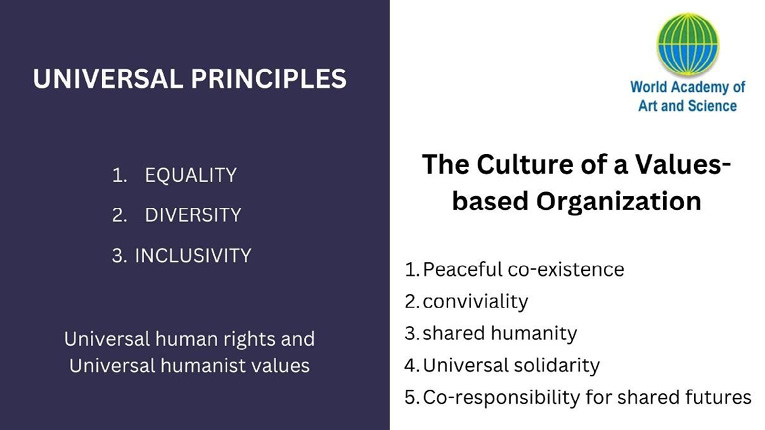
With regard to the principles of a values-based organization, namely: peaceful co-existence, conviviality, shared humanity; universal solidarity; and co-responsibility for shared futures, we need to ask ourselves:
Thereby, WAAS can contribute towards the universal principles the world needs today.
Education is humanity’s most developed and powerful instrument for conscious social evolution and cultural development. Advancement in the content, quality, and accessibility to education at all levels is the most effective instrument for addressing the rising levels of uncertainty and insecurity. Reshaping education can enhance understanding, shape attitudes, instill values, and impart the knowledge and skills needed by citizens at all levels to adjust with the rapidity of change, seize on emerging opportunities and acquire the ability to survive and thrive in the future that is approaching. Therefore, an emphasis on accelerated development of a new paradigm in pedagogy, content and delivery systems is of paramount importance for fostering peace, human security and sustainable development.
The system of education prevalent worldwide today is far too slow in recognizing, assimilating and incorporating new knowledge, pedagogy and delivery systems appropriate for the fast-approaching future. Technology changes rapidly. Concepts, perspectives, theories, courses and disciplines evolve much more slowly and changes are subject to significant resistance from established beliefs, existing practices, and efforts to preserve the status and survival of existing institutions at a time when radical change is most needed.
Since the founding of WAAS, it has become evident that fundamental changes in content, pedagogy and delivery systems are urgently required. During the first decade of its existence, WAAS established an informal World University which operated within the Academy for a few decades. Its aim was to take initial steps toward evolution of a transnational, transdisciplinary approach to higher education and research founded on universal values and focused on addressing global social challenges.
“The world university proposes to identify and to serve the common interest of mankind. (Its) auspices are transnational and representative of the highest level of achievement in the advancement of knowledge… the emphasis is interdisciplinary and provides for continuing consideration of the social consequences and social implication of knowledge.”
Since then the importance of higher education for the security and well-being of humanity and other life on the planet has multiplied exponentially. Systems, methods, theories and classifications of knowledge that were revered in the past are no longer adequate to generate or effectively disseminate the knowledge needed by younger generations to individually and collectively thrive in an increasingly complex, interconnected and rapidly changing world. Recent advances have brought into prominence the fundamental interlinkages and interdependence between phenomena which cannot be adequately reflected or captured by specialized theories, subdisciplines and disciplinary silos.
Moreover, the soaring demand for higher education far exceeds the capacity of the existing, high-cost delivery system. A decade ago, UNESCO estimated that the demand for higher education would necessitate establishing five universities a week the size of Harvard for the next fifteen years.††††††††† The astronomical cost of such enterprise and the shortage of qualified instructors and administrators to operate it, which is already a serious problem in most developing countries, would pose extreme obstacles to the endeavor. Moreover, the serious gap in quality between the best and average institutions would only grow greater as population expanded and the speed of social change accelerated.
7.1. New Paradigm in Higher Education
A new paradigm in education is essential to overcome the fragmentation of disciplinary silos and sectoral boundaries and view the world from a comprehensive, integrated perspective. Prevailing theory in the social sciences which perpetuated outdated concepts and theories will have to be radically overhauled to reflect rapidly emerging realities. This was especially but not exclusively true in the field of economics, which prompted WAAS to launch an initiative in 2011 to identify the contours of a transdisciplinary, integrated, human-centered economic theory.
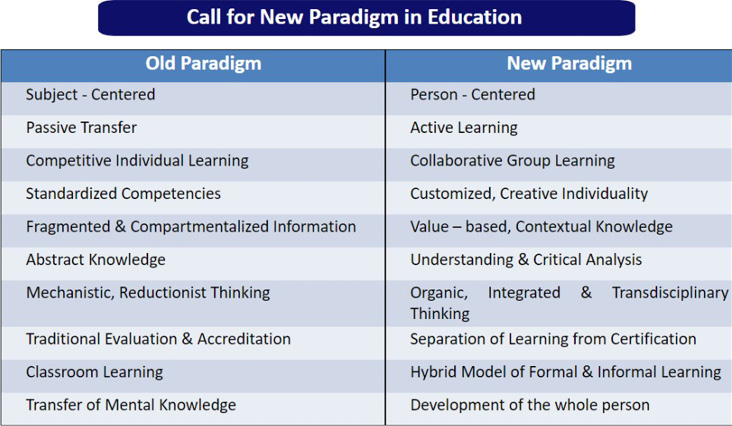
In 2013 WAAS concluded that radical changes in education were essential to address the whole spectrum of global challenges and it began a quest to conceive of a new paradigm in higher education.‡‡‡‡‡‡‡‡‡ Later the same year, WAAS conducted the first in a series of international conferences on future education at the University of California at Berkeley to explore the potentials of online education through MOOCs such as Coursera and edX, which were in the early stages of development.
7.2. World University Consortium
In 2014 WAAS joined together with a small group of partner organizations to establish the World University Consortium (WUC) with the mission of reshaping the pedagogy, content and delivery systems for global higher education. WUC’s work focused on three major areas. First, design possibilities for a global delivery system that could provide world class, affordable, accessible education to all who seek it. Second, a shift from a subject-centered to a person-centered pedagogy. Third, development of original, trans-disciplinary, collaborative courses and learning experiences to provide the knowledge and values needed to address global challenges and better prepare younger generations for life in a rapidly changing world.
Over the last decade, WAAS and WUC have organized six international conferences, conducted fifteen curriculum development projects, and published more than fifty articles on these issues. One of the initiatives of the HS4A project in 2024 will be the development and delivery of courses for formal and non-formal education by a reconstitution and revamping of the World University Consortium.§§§§§§§§§
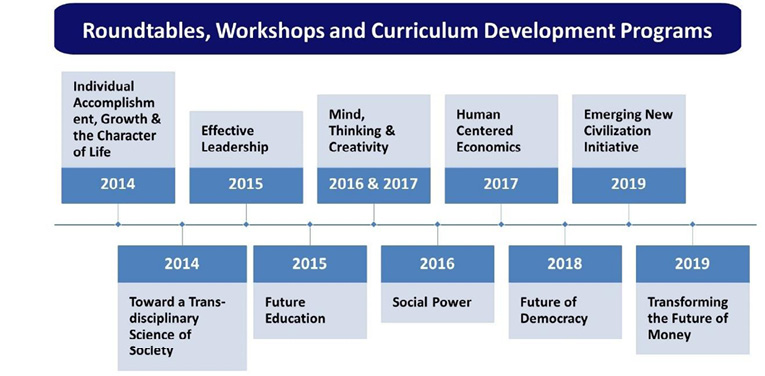
From the outset, the work of the Academy has addressed both theoretical and practical issues related to knowledge and its expression in society. Over the past decade the WAAS has explored important theoretical issues that will form the basis for future knowledge and action through a series of curriculum development workshops at the Inter-University Center in Dubrovnik.¶¶¶¶¶¶¶¶¶
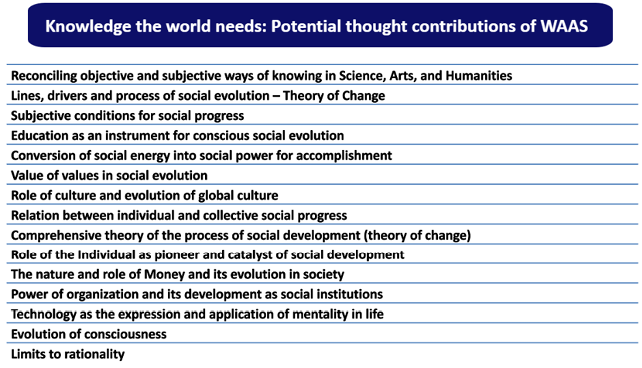
These and other recently emerging issues will continue to require our attention in future. The quest for new ways of thinking and understanding the complexity of social reality are as relevant today as they were at the time of the Academy’s founding. Long after the mysteries of atoms, quarks and neurons are unraveled and quantum computing has vastly extended the marvelous capacities of AI, perplexing questions will remain challenging the most deep-seated convictions about fundamental issues regarding the nature of personality, individuality, social processes, the nature of money, leadership, rationality, creativity, genius and consciousness that defy resolution by prevailing concepts and methods.**********
Reframing Bretton Woods for Human Security and Sustainable Development for All: The need for new thinking and theory in Economics and other social sciences has been discussed earlier in this paper. The central importance of the need for new thinking on fundamental concepts and theories is very evident in terms of governance with regard to multilateral institutions, international law and prevailing policies. For example, the need for altering the structure and policies of Bretton Woods institutions has been recognized and discussed for many decades. As understanding of the intricate interdependencies between nations, sectors and dimensions of global social existence advances, each successive version is compelled to take into account new dimensions omitted from earlier consideration. Events of the past four years have further reinforced both the awareness and the need for a reframing that takes into account the importance of all dimensions incorporated in the 17 SDGs and places human security for all at the center of all effort to promote the future development of global society. Without advances in theory, perspective, values, objectives and understanding of the underlying processes of global social evolution, addressing this and other perplexing issues will not be possible. Thus, the focus on action and impact must be accompanied by continued examination of the theoretical premises and framework underpinning global society today. As Einstein reminds us, the source of every problem can be traced back to deficiencies in our way of perceiving and thinking about reality. A focus on identifying and fostering leadership in thinking, regardless of the field or the source, will inevitably lead to the solutions that defy logic due to limitations in our way of thinking. The ultimate answer to funding the SDGs lies here.
7.4. Potential Programming for Higher Education
The past decade of research has identified a variety of high-potential areas for future programming in the field of education, including –
These diverse examples are in fields that fall within the wider framework in which WAAS and many Fellows of WAAS are already engaged. They illustrate the rich potential of the Academy to provide further leadership both in thought and action.
8. Proposals for Future WAAS Programming
The Academy invites project proposals that are aligned with the WAAS program framework and criteria discussed in this paper and summarized here:
8.1. WAAS@64 Calls for Conference Proposals
Proposals for programs, activities and working groups can be presented and discussed during the 2024 upcoming WAAS@64conference and general assembly which will take place online or in hybrid format during the period May-June. This event is intended to provide an opportunity for Fellows to participate in existing WAAS activities, propose new programs, collaborate with other Fellows through joint projects, and involve their own networks to expand and enrich the Academy’s activities, impact and outreach.
* Hugo Boyko, “The Need of a World Academy of Art and Science”, Science and the Future of Mankind, Dr. W. Junk Publishers, Netherlands, 1961
†For a discussion of reliable knowledge, see “Retrospective and Reflections on WAAS@60”, by Garry Jacobs, Cadmus Journal, June 24, 2021.
‡‡‡ https://www.pewresearch.org/short-reads/2023/08/31/people-across-24-countries-continue-to-view-un-
†††† Impact Initiatives, HS4A & F4G by Ketan Patel
¶¶¶¶ Human Security: Quantification & Acceleration https://worldacademy.org/conference-page/waas-talks-series/quantitative-methods-and-tools-for-human-security/
‡‡‡‡‡ Technology as a Force for Good: Technology Driving the Transition to a Superior Future, January 2024
****** Impact Initiatives, HS4A & F4G by Ketan Patel
†††††† Report on the World Conference on Basic Sciences and Sustainable Development, Belgrade, Serbia
¶¶¶¶¶¶ https://www.millennium-project.org/transition-from-artificial-narrow-to-artificial-general-intelligence-governance
******* What will stop AI from flooding the internet with fake images? | Shirin Ghaffary | Vox.com
††††††† Oren Etzioni, Former CEO of and current advisor to Al2, a US-based non-profit research institute focusing on Al and its implications.
‡‡‡‡‡‡‡ For video of the discussion see https://worldacademy.org/conference-on-global-leadership-for-the-21st-century- restoring-public-trust-and-the-role-of-media/
§§§§§§§ Information, Disinformation; Social Media and AI by Jon Miller
‡‡‡‡‡‡‡‡ Impact Initiatives: HS4A and F4G by Ketan Patel
¶¶¶¶¶¶¶¶ by Ketan Patel
********* The Culture of a Values-based Organization by Mila Popovich
††††††††† Garry Jacobs, New Paradigm: The Necessity and the Opportunity Cadmus Journal 2, no.2 (2014): 9-23 reprint-cj- v2-i2-new-paradigm-the-necessity-gjacobs.pdf (cadmusjournal.org)
†††††††††† A transdisciplinary theory of social development was explored by WAAS at a three-day conference in 1999 and discussed in WAAS publication Human Choice: The Genetic Code for Social Development by Harlan Cleveland and four other authors
‡‡‡‡‡‡‡‡‡‡ The initiative was launched by Alberto Zucconi, WAAS Chair and President of the Person-Centered Approach Institute (IACP) as an official collaboration with WAAS, WUC, Psychological Department, Torino University (UNITO), University for Sustainability (U4S), Black Sea Universities Network (BSUN), PoP Movement and the Ukrainian Psychological Association.





